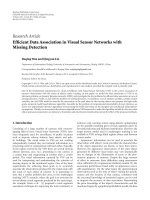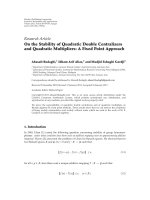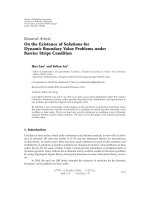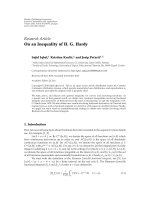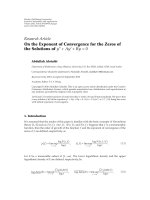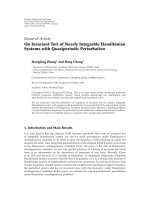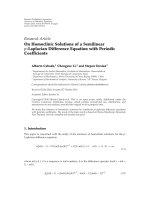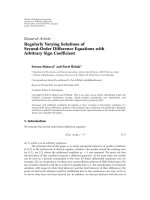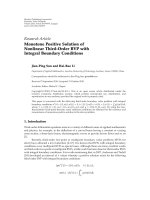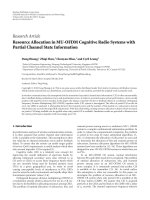báo cáo hóa học:" Research Article On Invariant Tori of Nearly Integrable Hamiltonian Systems with Quasiperiodic Perturbation" ppt
Bạn đang xem bản rút gọn của tài liệu. Xem và tải ngay bản đầy đủ của tài liệu tại đây (542.27 KB, 17 trang )
Hindawi Publishing Corporation
Fixed Point Theory and Applications
Volume 2010, Article ID 697343, 17 pages
doi:10.1155/2010/697343
Research Article
On Invariant Tori of Nearly Integrable Hamiltonian
Systems with Quasiperiodic Perturbation
Dongfeng Zhang
1
and Rong Cheng
2
1
Department of Mathematics, Southeast University, Nanjing 210096, China
2
College of Mathematics and Physics, Nanjing University of Information Science and Technology,
Nanjing 210044, China
Correspondence should be addressed to Dongfeng Zhang,
Received 2 September 2010; Accepted 25 October 2010
Academic Editor: Marl
`
ene Frigon
Copyright q 2010 D. Zhang and R. Cheng. This is an open access article distributed under the
Creative Commons Attribution License, which permits unrestricted use, distribution, and
reproduction in any medium, provided the original work is properly cited.
We are concerned with the persistence of frequency of invariant tori for analytic integrable
Hamiltonian system with quasiperiodic perturbation. It is proved that if the unperturbed system
satisfies the R
¨
ussmann’s nondegeneracy condition and has nonzero Brouwer’s topological degree
at some Diophantine frequency; the perturbed system satisfies the colinked nonresonant condition,
then the invariant torus with this frequency persists under quasiperiodic perturbation.
1. Introduction and Main Results
It is well known that the classical KAM theorem concludes that most of invariant tori
of integrable Hamiltonian system can survive small perturbation under Kolmogorov’s
nondegeneracy condition 1–4. What is more, the frequency of the persisting invariant tori
remains the same. Later important generalizations of the classical KAM theorem were made
to the R
¨
ussmann’s nondegeneracy condition 5–9. However, in the case of R
¨
ussmann’s
nondegeneracy condition, we can only get the existence of a family of invariant tori while
there is no information on the persistence of frequency of any torus. Recently, Chow
et al. 10 and Sevryuk 11 consider perturbations of moderately degenerate integrable
Hamiltonian system and prove that the first d frequencies d<n, n denotes the freedom of
Hamiltonian system of unperturbed invariant n-tori can persist. Xu and You 12 prove that
if some frequency satisfies certain nonresonant condition and topological degree condition,
the perturbed system still has an invariant torus with this frequency under R
¨
ussmann’s
nondegeneracy condition. In this paper, we consider the case of quasiperiodic perturbation
under R
¨
ussmann’s nondegeneracy condition.
2 Fixed Point Theory and Applications
Consider the following Hamiltonian:
H h
y
p
x, y, ωt
, 1.1
where y ∈ D ⊂ R
n
,x ∈ T
n
, ω ∈ R
m
,hand p are real analytic on a complex neighborhood of
D × T
n
× T
m
,Dis a closed bounded domain, T
n
, T
m
denote n-torus and m-torus, respectively,
and px, y, ωt is a perturbation and quasiperiodic in φ ωt. Here, a function ft is called
a quasiperiodic function with the vector of basic frequencies ω ω
1
, ω
2
, , ω
m
if there is
function ftFφ
1
,φ
2
, ,φ
m
, where F is 2π periodic in all of its arguments φ
j
ω
j
t for
j 1, 2, ,m.
After introducing two conjugate variables φ mod 2π and η, the Hamiltonian 1.1 can
be written in the form of an autonomous Hamiltonian with n m degrees of freedom as
follows:
H h
y
ω, η
p
x, y, φ
. 1.2
Thus, the perturbed motion of Hamiltonian 1.1 is described by the following equations:
˙x H
y
h
y
y
p
y
x, y, φ
,
˙y −H
x
−p
x
x, y, φ
,
˙
φ H
η
ω,
˙η −H
φ
−p
φ
x, y, φ
.
1.3
Suppose that the frequency mapping
ωy∂hy/∂y satisfies R
¨
ussmann’s nondegeneracy
condition
a
1
ω
1
y
a
2
ω
2
y
··· a
n
ω
n
y
/
≡ 0onD, 1.4
for all a
1
,a
2
, ,a
n
∈ R
n
\{0}. The condition 1.4 is first given in 6 by R
¨
ussmann, and it
is the sharpest one for KAM theorems.
When p 0, the unperturbed system 1.3 has invariant tori T
0
T
n
× T
m
×{0}×{0}
with frequency ω
ωy, ω, carrying a quasiperiodic flow xtωyt x
0
,φt ωt φ
0
.
When p
/
0, given a frequency ω
ω
0
, ω satisfying certain Diophantine condition,
we are concerned with the existence of invariant torus with ω as its frequency for
Hamiltonian system 1.3. The following theorem will give a positive answer.
Theorem 1.1. Consider the real analytic Hamiltonian system 1.3.Let
ωyh
y
y and ω
0
ωy
0
,y
0
∈ D. Suppose that ω ω
0
, ω satisfies the Diophantine condition as follows:
k
,
ω
0
k
, ω
≥
α
|
k
|
τ
, ∀0
/
k
k
,
k
∈ Z
nm
,
1.5
Fixed Point Theory and Applications 3
and the Brouwer’s topological degree of the frequency mapping
ωy at ω
0
on D is not zero, that is,
deg
ω
y
,D,ω
0
/
0, 1.6
then there exists a sufficiently small >0, such that if
p
sup
D×T
n
×T
m
p
x, y, φ
≤ ,
1.7
the system 1.3 has an invariant torus with ω
ω
0
, ω as its frequency.
Remark 1.2. In 13 the authors only obtained the existence of invariant tori for Hamiltonian
systems 1.3, while the frequency of the persisting invariant tori may have some drifts.
As in 4, instead of proving Theorem 1.1 directly, we are going to deduce it
from another KAM theorem, which is concerned with perturbations of a family of
linear Hamiltonians. This is accomplished by introducing a parameter and changing the
Hamiltonian system 1.3 to a parameterized system. For ξ ∈ D, let y ξ z, then
H e
ξ
ω
ξ
,z
ω, η
p
x, ξ z, φ
O
z
2
, 1.8
where eξhξ,
ωξh
y
ξ,ξ∈ D is regarded as parameters. Since eξ is an energy
constant, which is usually omitted, and the term O|z
2
| can be taken as a new perturbation,
we consider the Hamiltonian
H
x, z, φ, η; ξ
ω
ξ
,z
ω, η
P
x, z, φ; ξ
N P,
1.9
where N
ωξ,z ω, η is a normal form, P Px, z, φ; ξ is a small perturbation.
Let
D
s, r
x, φ,z, η
|
|
Im x
|
≤ s,
Im φ
≤ s,
|
z
|
≤ r,
η
≤ r
⊂ C
n
/2πZ
n
× C
m
/2πZ
m
× C
n
× C
m
,
Λ
{
ξ ∈ D | dist
ξ, ∂D
≥ σ
}
,
1.10
where σ ≥ r>0 is a small constant. Let Λ
σ
be the complex neighborhood of Λ with the radius
σ, that is,
Λ
σ
{
ξ ∈ C
n
| dist
ξ, Λ
≤ σ
}
. 1.11
4 Fixed Point Theory and Applications
Now, the Hamiltonian Hx, φ, z, η; ξ is real analytic on Ds, r×Λ
σ
. The corresponding
Hamiltonian system becomes
˙x H
z
ω
ξ
P
z
x, z, φ; ξ
,
˙z −H
x
−P
x
x, z, φ; ξ
,
˙
φ H
η
ω,
˙η −H
φ
−P
φ
x, z, φ; ξ
.
1.12
Thus, the persistence of invariant tori for nearly integrable Hamiltonian system 1.3 is
reduced to the persistence of invariant tori for the family of Hamiltonian system 1.12
depending on the parameter ξ.
We expand
P
x, z, φ; ξ
k,
k∈Z
n
×Z
m
P
k
z; ξ
e
ik,x
k,φ
,
1.13
then we define
P
Ds,r×Λ
σ
sup
D
s,r
×Λ
σ
k,
k∈Z
n
×Z
m
P
k
z; ξ
e
ik,x
k,φ
.
1.14
Theorem 1.3. Suppose that Hx, z, φ, η; ξ
ωξ,z ω, η P x, z, φ; ξ is real analytic on
Ds, r × Λ
σ
. Let ω
0
ωξ
0
,ξ
0
∈ Λ. Suppose that ω
0
satisfies 1.5 and degωξ, Λ, ω
0
/
0, then
there exists a sufficiently small >0, such that if P
Ds,r×Λ
σ
≤ , there exists ξ
∗
∈ Λ, such that the
Hamiltonian system 1.12 at ξ ξ
∗
has an invariant torus with ω
0
, ω as its frequency.
2. Proof of the Main Results
In order to prove Theorem 1.3, we introduce an external parameter λ and consider the
following Hamiltonian system:
˙x H
z
ω
ξ
λ P
z
x, z, φ; ξ
,
˙z −H
x
−P
x
x, z, φ; ξ
,
˙
φ H
η
ω,
˙η −H
φ
−P
φ
x, z, φ; ξ
,
2.1
where Hx, z, φ, η; ξ,λ
ωξλ, z ω, η Px, z, φ; ξ. When λ 0, the Hamiltonian
system 2.1 comes back to the system 1.12. The idea of introducing outer parameters was
used in 8, 11, 12. We first give a KAM theorem for Hamiltonian system with parameters
ξ, λ.
Fixed Point Theory and Applications 5
Let d max
ξ,γ∈Λ
σ
|ωξ − ωγ| and define
B
ω
ξ
,d
{
λ ∈ C
n
| dist
λ, ω
ξ
<d
}
. 2.2
Let O
ξ∈Λ
σ
Bωξ,d ∩ R
n
. We have ωΛ {ωξ | ξ ∈ Λ}⊂O, and define
O
α
Ω ∈O|
k
, Ω
k
, ω
≥
α
|
k
|
τ
, ∀0
/
k
k
,
k
∈ Z
nm
.
2.3
Let K>0andh α/2K
τ1
. Denote O
α,h
the complex neighborhood of O
α
with radius h, then
for any Ω ∈O
α,h
, we have
k, Ω
k, ω
≥
α
2
|
k
|
τ
, ∀0
/
|
k
|
≤ K.
2.4
Let ΠΛ
σ
× B0, 2d 1. The Hamiltonian Hx, z, φ, η; ξ,λ is real analytic on Ds, r × Π.
Theorem 2.1. Consider the parameterized Hamiltonian system 2.1, which is real analytic on
Ds, r × Π. Then there exists a sufficiently small >0, such that if P
Ds,r×Π
≤ , there exists
a Cantor-like family of analytic curves
Γ
∗
Ω
{
ξ, λ
ξ
| ξ ∈ Λ, Ω ∈O
α
}
⊂ Π, 2.5
which are determined implicitly by the equation
λ
ω
ξ
F
∗
ξ, λ
Ω, 2.6
where F
∗
ξ, λ is C
∞
-smooth in ξ, λ on Π and satisfies
|
F
∗
ξ, λ
|
≤
2
r
,
F
∗ξ
ξ, λ
|
F
∗λ
ξ, λ
|
≤
1
2
,
2.7
and a parameterized family of symplectic mappings
Ψ
∗
·, ·; ξ, λ
: D
s
2
,
r
2
−→ D
s, r
,
ξ, λ
∈ Γ
∗
Ω∈O
α
Γ
∗
Ω
,
2.8
where Ψ
∗
is C
∞
-smooth in ξ, λ on Γ
∗
in the sense of Whitney and analytic in x, φ, z on
Ds/2,r/2, such that for each ξ, η ∈ Γ
∗
, one has
H ◦ Ψ
∗
Ω,z
ω, η
P
∗
x, z, φ; ξ,λ
, 2.9
where P
∗
x, z, φ; ξ,λO|z|
2
near z 0. Thus, the perturbed system 2.1 possesses invariant tori
with Ω, ω as its frequency.
6 Fixed Point Theory and Applications
Remark 2.2. The derivatives in the estimates of 2.7 should be understood in the sense of
Whitney 14. In fact, we can extend F
∗
ξ, λ to a neighborhood of Γ
∗
Ω
as a consequence in
15.
Remark 2.3. In fact, we can prove that Ψ
∗
is Gevrey smooth with respect to the parameters
ξ, λ in the sense of Whitney as in 16–18.
Proof of Theorem 1.3. Now, we use the results of Theorem 2.1 to prove Theorem 1.3. In fact,
Let Ω
ω
0
, then we have an analytic curve Γ
∗
ω
0
: λ λξ,ξ ∈ Λ, which is determined by the
equation λ
ωξF
∗
ξ, λω
0
. By implicit function theorem, we have
λ
ξ
ω
0
− ω
ξ
λ
∗
ξ
,ξ∈ Λ, 2.10
where λ
∗
ξ satisfies that
|
λ
∗
ξ
|
≤
2
r
,
λ
∗ξ
ξ
≤
4
r
.
2.11
By the assumption deg
ωξ, Λ, ω
0
/
0, if is sufficiently small, we have
deg
λ
ξ
, Λ, 0
deg
ω
0
− ω
ξ
, Λ, 0
/
0. 2.12
Therefore, we have some ξ
∗
∈ Λ such that λξ
∗
0. When λξ
∗
0, the Hamiltonian system
2.1 comes back to the system 1.12. Therefore, by Theorem 2.1,atξ
∗
the Hamiltonian system
1.12 has an invariant torus with
ω
0
, ω as its frequency.
Now, it remains to prove Theorem 2.1. Our method is the standard KAM iteration. The
difficulty is how to deal with parameters in KAM iteration.
KAM Step
The KAM step can be summarized in the following lemma.
Lemma 2.4. Consider real analytic Hamiltonian
H
Ω
ξ, λ
,z
ω, η
P
x, z, φ; ξ,λ
, 2.13
which is defined on Ds, r × Π, where Ωξ, λ
ωξλ fξ, λ. Suppose that
P
Ds,r×Π
≤ .
2.14
Suppose that the function fξ,λ satisfies that
f
ξ
ξ, λ
f
λ
ξ, λ
<
1
2
, ∀
ξ, λ
∈ Π
, 2.15
Fixed Point Theory and Applications 7
and then for all Ω ∈O
α
, the equation
Ω
ξ, λ
ω
ξ
λ f
ξ, λ
Ω 2.16
defines implicitly an analytic mapping as follows:
λ : ξ ∈ Λ
σ
−→ λ
ξ
∈ B
0, 2d 1
, 2.17
such that Γ
Ω
{ξ, λξ | ξ ∈ Λ
σ
}⊂Π. Moreover one defines
δ
α
2LK
τ1
with L 2 max
ξ∈Λ
σ
ω
ξ
ξ
,
2.18
B
Γ
Ω
,δ
ξ, λ
∈ C
n
× C
n
,
ξ, λ
∈ Γ
Ω
|
λ
− λ
≤ δ
⊂ Π. 2.19
Then there exist Π
⊂ Π and Ds
,r
, such that for any ξ, λ ∈ Π
there exists a symplectic
mapping
Φ
·, ·; ξ, λ
: D
s
,r
−→ D
s, r
, 2.20
such that
H
H ◦ Φ
Ω
ξ, λ
,z
ω, η
P
x, z, φ; ξ,λ
, 2.21
where Ω
ξ, λωξλ fξ,λf
ξ, λ. Moreover, the new perturbation satisfies
P
Ds
,r
×Π
≤ c
2
αrρ
nτ1
K
n
e
−Kρ
μ
2
, 2.22
where s
s − 5ρ, r
μr, and
Π
ξ, λ
∈ C
n
× C
n
| ξ ∈ Λ
σ−1/2δ
,
ξ, λ
∈ Γ,
λ
− λ
≤
1
2
δ
, 2.23
with Γ
Ω∈O
α
Γ
Ω
.
The term f
ξ, λ which may generate the drift of frequency after one KAM step satisfies that
f
ξ, λ
≤
r
, ∀
ξ, λ
∈ Π,
f
ξ
ξ, λ
f
λ
ξ, λ
≤
2
δr
, ∀
ξ, λ
∈ Π
.
2.24
Thus, if
2
δr
≤
1
4
,
2.25
8 Fixed Point Theory and Applications
then the equation
Ω
ξ, λ
ω
ξ
λ f
ξ, λ
f
ξ, λ
Ω 2.26
determines an analytic mapping
λ
: ξ ∈ Λ
σ
−→ λ
ξ
∈ B
0, 2d 1
, 2.27
with σ
σ − 1/2δ, satisfying
|
λ
ξ
− λ
ξ
|
≤
2
r
≤
δ
4
,
2.28
Γ
Ω
{
ξ, λ
ξ
| ξ ∈ Λ
σ
}
⊂ Π
. 2.29
For K
> 0, define δ
α/2LK
τ1
. If
δ
<
δ
4
,
2.30
then for all Ω ∈O
α
one has BΓ
Ω
,δ
⊂ Π
.
Proof of Lemma 2.4. We divide the proof into several parts.
(A) Truncation
Since P is real analytic, consider the Taylor-Fourier series of P as follows:
P
k∈Z
n
,
k∈Z
m
,q∈Z
n
P
k
k
q
ξ, λ
z
q
e
ik,x
k,φ
.
2.31
Let the truncation R of P have the following form:
R
k∈Z
n
,
k∈Z
m
, |k|≤K
P
k
k
0
P
k
k
1
,z
e
ik,x
k,φ
,
2.32
where |k| |
k| |
k|,Kis a positive constant. Then,
R
Ds−ρ,r×Π
≤ c,
P − R
Ds−ρ,2μr×Π
≤ c
K
n
e
−Kρ
μ
2
. 2.33
Fixed Point Theory and Applications 9
(B) Extending the Small Divisor Estimate
By 2.16, the Diophantine condition 2.3 is satisfied for k,Ωξ, λ
k, ω, that is, f or all
parameters ξ, λ ∈ Γ
Ω∈O
α
Γ
Ω
. Moreover, the definition 2.18 of δ implies that
k, Ω
ξ, λ
k, ω
≥
α
2
|
k
|
τ
, ∀0
/
|
k
|
≤ K
, 2.34
for all ξ, λ ∈ BΓ,δ. Indeed, for all ξ
,λ
∈ BΓ,δ, there is some ξ, λ ∈ Γ satisfying
|ξ − ξ
| |λ − λ
|≤δ, hence
k, Ω
ξ
,λ
− Ω
ξ, λ
k, ω
ξ
−
ω
ξ
λ
− λ f
ξ
,λ
− f
ξ, λ
≤
k
ω
ξ
f
ξ
ξ
− ξ
1
f
λ
λ
− λ
≤
k
2
ω
ξ
α
2LK
τ1
≤
α
2
|
k
|
τ
,
2.35
for 0 < |
k| |
k|≤K. Together with the estimate 2.3 for k, Ωξ, λ
k, ω, this proves the
claim.
(C) Construction of the Symplectic Mapping
The aim of this section is to find a Hamiltonian F, such that the time 1-map ΦX
t
F
|
t1
carries
H into a new normal form with a smaller perturbation. Formally, we assume that F is of the
following form:
F
0
/
|k|≤K
F
k
k
0
F
k
k
1
,z
e
ik,x
k,φ
2.36
if
{
N, F
}
R
− R, 2.37
where {·, ·} is the Poisson bracket, R
T
m
T
n
Rdxdφ, then,
H ◦ Φ
N R
◦ Φ
P − R
◦ Φ
N
R
{
N, F
}
R −
R
1
0
{
1 − t
{
N, F
}
R, F
}
◦ X
t
F
dt
P − R
◦ Φ
N
P
,
2.38
where N
N RΩ
ξ, λ,z ω, η,P
1
0
{1 − t{N, F} R, F}◦X
t
F
dt P − R ◦ Φ.
10 Fixed Point Theory and Applications
Putting 2.32 and 2.36 into 2.37 yields
0
/
|k|≤K
i
k, Ω
ξ, λ
k, ω
F
k
k0
F
k
k1
,z
e
ik,x
k,φ
0
/
|k|≤K
P
k
k
0
P
k
k
1
,z
e
ik,x
k,φ
.
2.39
Equation 2.39 is solvable because the Diophantine condition 2.34 is satisfied for all
parameters ξ, λ ∈ BΓ,δ, then we have
F
0
/
|k|≤K
P
k
k
0
P
k
k
1
,z
e
ik,x
k,φ
i
k, Ω
ξ, λ
k, ω
, ∀
ξ, λ
∈ B
Γ,δ
,
2.40
which satisfies F
Ds−2ρ,r×BΓ,δ
≤ c/αρ
τn
.
Moreover, with the estimate of Cauchy, we get F
x
Ds−3ρ,r
≤ c/αρ
τn1
,
F
φ
Ds−3ρ,r
≤ c/αρ
τn1
, and F
z
Ds−2ρ,r/2
≤ c/αrρ
τn
, hence
1
r
F
x
,
1
r
F
φ
,
1
ρ
F
z
≤
c
αrρ
τn1
, 2.41
uniformly on Ds − 3ρ, r/2 × BΓ,δ.
(D) Estimates of the Symplectic Mapping
The coordinate transformation Φ is obtained as the time 1-map of the flow X
t
F
of the
Hamiltonian vectorfield X
F
, with equations
˙z −F
x
, ˙η −F
φ
, ˙x F
z
,
˙
φ F
η
0. 2.42
Thus, if 0 <μ≤ 1/8and is sufficiently small, we have for all ξ, λ ∈ BΓ,δ,
Φ
·, ·; ξ, λ
X
1
F
:
s − 4ρ, 2μr
−→
s − 3ρ, 3μr
,
2.43
|
U
1
− id
|
≤
F
x
≤
c
αρ
τn1
,
|
U
2
− id
|
≤
F
φ
≤
c
αρ
τn1
,
|
V − id
|
≤
F
z
≤
c
αrρ
τn
,
2.44
on Ds − 4ρ, 2μr × BΓ,δ for ΦU
1
x, φ,z,U
2
x, φ,z,Vx, φ, where U
1
,U
2
is affine in
z,andV is independent of z.
Let W diagr
−1
I
n
,r
−1
I
m
,ρ
−1
I
n
, where I
n
is the nth unit matrix. Thus, it follows that
W
Φ − id
Ds−4ρ,2μr×BΓ,δ
≤
c
αrρ
τn1
.
2.45
Fixed Point Theory and Applications 11
By the preceding estimates and the Cauchy’s estimate, we have
W
DΦ − Id
W
−1
Ds−5ρ,μr×BΓ,δ
≤
c
αrρ
τn1
,
2.46
where DΦ denotes the Jacobian matrix with respect to z, x, φ.
(E) Estimates of New Error Term
To estimate P
, we first consider the term {R, F}. By Cauchy’s estimate,
{
R, F
}
Ds−3ρ,r/2
≤ c
R
z
F
x
R
x
F
z
≤ c
r
·
αρ
τn1
ρ
·
αrρ
τn
≤
c
2
αrρ
τn1
.
2.47
The same holds for {{N, F},F}
Ds−3ρ,r/2
. Together with 2.43 and μ ≤ 1/8, we get
1
0
{
1 − t
{
N, F
}
R, F
}
◦ X
t
F
dt
Ds−5ρ,μr
≤
{
1 − t
{
N, F
}
R, F
}
Ds−4ρ,2μr
≤
c
2
αrρ
τn1
.
2.48
The other term in P
is bounded by
P − R
◦ Φ
Ds−5ρ,μr
≤
P − R
Ds−4ρ,2μr
≤ c
K
n
e
−Kρ
μ
2
.
2.49
Let s
s − 5ρ, r
μr. The preceding estimates are uniform in the domain of parameters
BΓ,δ, so the new perturbation satisfies that
P
Ds
,r
×Π
≤ c
2
αrρ
τn1
K
n
e
−Kρ
μ
2
. 2.50
Since f
ξ, λP
001
, the estimate for f
holds. Let Π
be defined as in Lemma 2.4, we have
distΠ
,∂Π ≥ 1/2δ. Then, for all ξ, λ ∈ Π
, the Cauchy’s estimate yields the estimate for
f
ξ
ξ, λ and f
λ
ξ, λ. Moreover, by 2.25 , we have
∂Ω
ξ, λ
∂λ
≥ 1 −
f
λ
ξ, λ
−
f
λ
ξ, λ
≥
1
4
/
0.
2.51
Thus, by the implicit function theorem, the equation
Ω
ξ, λ
ω
ξ
λ f
ξ, λ
f
ξ, λ
Ω 2.52
12 Fixed Point Theory and Applications
determines an analytic curve
λ
: ξ ∈ Λ
σ
−→ λ
ξ
. 2.53
Moreover, we have
|
λ
ξ
− λ
ξ
|
≤
f
λ
·
|
λ
− λ
|
f
ξ, λ
≤
1
2
|
λ
− λ
|
r
,
2.54
this proves 2.28. By the estimates 2.28 and 2.30, the conclusion Γ
Ω
⊂ Π
,BΓ
Ω
,δ
⊂ Π
holds. Thus, the proof of Lemma 2.4 is complete.
KAM Iteration
In this section, we have two tasks which ensure that the above iteration can go on infinitely.
The first one is to choose some suitable parameters, the other one is to verify some
assumptions in Lemma 2.4.
For given ρ
0
s/20,r
0
r, s
0
s,
0
αr
0
ρ
τn1
0
E
0
, and μ
0
E
1/2
0
,K
0
is determined by
K
n
0
e
−K
0
ρ
0
E
0
, we define ρ
j1
ρ
j
/2,s
j1
s
j
− 5ρ
j
,μ
j
E
1/2
j
,r
j1
μ
j
r
j
,E
j1
cE
3/2
j
, and
j1
αr
j1
ρ
τn1
j1
E
j1
,K
j1
is determined by the equation K
n
j1
e
−K
j1
ρ
j1
E
j1
.
Let Π
0
Λ
0
× B0, 2d 1,D
0
Ds
0
,r
0
. By the iteration lemma, we have a sequence
of parameter sets Π
j
with Π
j1
⊂ Π
j
and a sequence of symplectic mappings Φ
j
such that
Φ
j
: D
j1
× Π
j1
→ D
j
× Π
j
, where D
j
Ds
j
,r
j
. Moreover, we have
W
j
Φ
j
− id
D
j
×Π
j
≤ cE
j
,
W
j
DΦ
j
− Id
W
−1
j
D
j
×Π
j
≤ cE
j
,
2.55
where W
j
diagr
−1
j
I
n
,r
−1
j
I
m
,ρ
−1
j
I
n
.
Let Ψ
j
Φ
0
◦ Φ
1
◦···◦Φ
j−1
with Ψ
0
id, then
H
j
H
0
◦ Ψ
j
N
j
P
j
, 2.56
where N
j
Ω
j
ξ, λ,z ω, η, and Ω
j
ξ, λωξλ Σ
j−1
i0
f
i
ξ, λ.
Let δ
j
α/2LK
τ1
j
,σ
j
σ
j−1
− 1/2δ
j−1
, where L 2 max
ξ∈Λ
σ
j
|ω
ξ
ξ|,σ
0
σ. From
the iteration lemma, we have that for all Ω ∈O
α
, the equation
Ω
j
ξ, λ
ω
ξ
λ Σ
j−1
i0
f
i
ξ, λ
Ω
2.57
Fixed Point Theory and Applications 13
on Π
j
defines implicitly an analytic mapping λ λ
j
ξ,ξ ∈ Λ
σ
j
, whose image in Π
j
forms an
analytic curve Γ
j
Ω
. Let Γ
j
Ω∈O
α
Γ
j
Ω
. We define
Π
j1
ξ, λ
∈ C
n
× C
n
| ξ ∈ Λ
σ
j1
,
ξ, λ
∈ Γ
j
,
λ
− λ
≤
1
2
δ
j
, 2.58
which satisfies the property Π
j1
⊂ Π
j
, distΠ
j1
,∂Π
j
≥ 1/2δ
j
.
Let f
j
ξ, λΩ
j1
ξ, λ − Ω
j
ξ, λ, then we have
f
j
ξ, λ
≤
j
r
j
, ∀
ξ, λ
∈ Π
j
,
f
jξ
ξ, λ
f
jλ
ξ, λ
≤
2
j
δ
j
r
j
, ∀
ξ, λ
∈ Π
j1
.
2.59
Moreover, we have
λ
j1
ξ
− λ
j
ξ
≤
2
j
r
j
, ∀
ξ, λ
∈ Π
j1
.
2.60
The new perturbation P
j
satisfies that P
D
j
×Π
j
≤
j
αr
j
ρ
τn1
j
E
j
.
In the following, we will check the assumptions in Lemma 2.4 to ensure that KAM step
is valid for all j ≥ 0.
Let G
j
2
j
/δ
j
r
j
. It follows that
G
j1
G
j
x
nτ1
j1
e
−x
j1
x
nτ1
j
e
−x
j
,
2.61
where x
j
K
j
ρ
j
. By E
j1
cE
3/2
j
, if E
0
is sufficiently small, E
j
are all sufficiently small and so
x
j
K
j
ρ
j
are sufficiently large. Since the function x
nτ1
e
−x
decreases as x>n τ 1, we can
choose a sufficiently small E
0
such that G
j1
/G
j
≤ 1/4andG
j
≤ 1/4, for all j ≥ 0. Moreover,
δ
j1
δ
j
1
2
τ1
x
j
x
j1
τ1
≤
1
4
.
2.62
Thus, the assumptions 2.25 and 2.30 hold.
Convergence of the Iteration
Now, we prove convergence of the KAM iteration. Let Π
∗
j≥0
Π
j
and Ψlim
j →∞
Ψ
j
. In
the same way as in 4, 13, we have the convergence Ψ
j
to Ψ on Ds/2,r/2 × Π
∗
, satisfying
that
W
0
Ψ − id
Ds/2,r/2×Π
∗
≤ cE
0
.
2.63
14 Fixed Point Theory and Applications
Let F
j
j−1
i0
f
i
ξ, λ. Now, we prove the convergence of F
j
. Combining with the
estimates for f
j
ξ, λ, we have for all ξ, λ ∈ Π
j
,
F
j
ξ, λ
≤
j−1
i0
δ
i
G
i
2
≤
δ
0
2
j−1
i0
G
i
≤
2
3
δ
0
G
0
≤
2
r
.
2.64
Similarly, it follows that for all ξ, λ ∈ Π
j
,
F
jξ
ξ, λ
F
jλ
ξ, λ
≤
j−1
i0
G
i
≤
4
3
G
0
16
3
Lx
τn1
0
e
−x
0
.
2.65
Then if E
0
is sufficiently small and so x
0
is sufficiently large, we have
F
jξ
ξ, λ
F
jλ
ξ, λ
≤
1
2
, ∀
ξ, λ
∈ Π
j
,
2.66
the assumption 2.15 holds.
Let F
∗
lim
j →∞
F
j
, then for all ξ, λ ∈ Π
∗
, we have
|
F
∗
ξ, λ
|
≤
2
r
,
F
∗ξ
ξ, λ
|
F
∗λ
ξ, λ
|
≤
1
2
.
2.67
This proves 2.7.
Let σ
∗
σ − 1/2
∞
j0
δ
j
. By 2.62, it follows that σ
∗
≥ σ − 2/3δ
0
. If E
0
is sufficiently
small such that δ
0
≤ σ, we have σ
∗
≥ 1/3σ. Thus, Λ
σ
∗
⊂
j≥0
Λ
σ
j
.
Similarly, we can prove the convergence of λ
j
ξ on Λ
σ
∗
. In fact, we can choose E
0
sufficiently small such that G
j
≤ 1/4, for all j ≥ 0. Then for l ≥ j, it follows that
λ
l
ξ
− λ
j
ξ
≤
l−1
ij
G
i
δ
i
≤
4
3
G
j
δ
j
≤
δ
j
2
.
2.68
Let λξlim
l →∞
λ
l
ξ, then we have
λ
ξ
− λ
j
ξ
≤
δ
j
2
.
2.69
This implies that Γ
∗
Ω
{ξ, λξ | ξ ∈ Λ
σ
∗
}⊂Π
j
. So Γ
∗
Ω∈O
α
Γ
∗
Ω
⊂ Π
∗
j≥0
Π
j
. Moreover,
for ξ, λ ∈ Γ
∗
, we have
ω
ξ
λ F
∗
ξ, λ
Ω. 2.70
Thus, the proof of Theorem 2.1 is complete.
Fixed Point Theory and Applications 15
3. Some Examples
Example 3.1. We consider the following system:
H
ω
1
y
1
y
4
1
4
ω
2
y
2
y
4
2
4
sin ω
1
t sin ω
2
t
,
3.1
where
N
ω
1
y
1
y
4
1
4
ω
2
y
2
y
4
2
4
,P
sin ω
1
t sin ω
2
t
.
3.2
The frequency mapping
ω
y
∂N
∂y
ω
1
y
3
1
,
ω
2
y
3
2
3.3
at y 0 does not satisfy the Kolmogorov’s nondegeneracy condition. But
Rank
ω
y
,
∂
ω
y
∂y
Rank
⎧
⎨
⎩
ω
1
y
3
1
3y
2
1
0
ω
2
y
3
2
03y
2
2
⎫
⎬
⎭
2. 3.4
So according to our theorem, if is sufficiently small, ω
ω, ω satisfies the Diophantine
condition and deg
ωy,D,ω
/
0, the perturbed system still has an invariant torus with ω
ω, ω as its frequency.
Example 3.2. We consider the following quasiperiodic mapping A:
x
1
x ω β
y
f
x, y
,
y
1
y g
x, y
,
3.5
where f and g are quasiperiodic in x with frequencies μ
1
, ,μ
m
, real analytic in x and y,
the variable y ranges in a neighborhood of the origin of real line R,ω is a positive constant.
Suppose that the mapping A is reversible with respect to the involution R : x, y → −x, y,
that is A ◦ R ◦ A R.
When dβy/dy
/
0,ωsatisfies certain Diophantine condition and f, g are sufficiently
small, the existence of invariant curve with ω as its frequency has been proved in 19, 20.The
condition dβy/dy
/
0 is called twist condition. The natural question is when the condition
dβy/dy
/
0 is not satisfied, that is, there is some y
∗
such that dβy
∗
/dy 0, whether there
exists invariant curve for mapping 3.5, whether its frequency can persist without any drift.
By the method of introducing an external parameter as in our paper, we can prove that the
mapping 3.5 still has an invariant curve with ω as its frequency, when βyy
2n1
. For
detailed proofs, we refer to 21.
Remark 3.3. When βyy
2n
, we can only prove the existence of invariant curve for the
mapping 3.5, but its frequency has some drifts.
16 Fixed Point Theory and Applications
Acknowledgments
The work was supported by the National Natural Science Foundation of China no.
10826035, no. 11001048 and the Specialized Research Fund for the Doctoral Program of
Higher Education for New Teachers no. 200802861043. It was also supported by the Science
Research Foundation of Nanjing University of Information Science and Technology no.
20070049.
References
1 V. I. Arnold, “Proof of a theorem of A. N. Kolmogorov on the preservation of conditionally periodic
motions under a small perturbation of the Hamiltonian,” Uspekhi Matematicheskikh Nauk, vol. 18, no.
5 113, pp. 13–40, 1963.
2 L. H. Eliasson, “Perturbations of stable invariant tori for Hamiltonian systems,” Annali della Scuola
Normale Superiore di Pisa, vol. 15, no. 1, pp. 115–147, 1988.
3 A. N. Kolmogorov, “On conservation of conditionally periodic motions for a small change in
Hamilton’s function,” Doklady Akademii Nauk SSSR, vol. 98, pp. 527–530, 1954.
4 J. P
¨
oschel, “A lecture on the classical KAM theorem,” in Smooth Ergodic Theory and Its Applications
(Seattle, WA, 1999), vol. 69 of Proc. Sympos. Pure Math., pp. 707–732, American Mathematical Society,
Providence, RI, USA, 2001.
5 C. Q. Cheng and Y. S. Sun, “Existence of KAM tori in degenerate Hamiltonian systems,” Journal of
Differential Equations, vol. 114, no. 1, pp. 288–335, 1994.
6 H. R
¨
ussmann, “Nondegeneracy in the perturbation theory of integrable dynamical systems,” in
Stochastics, Algebra and Analysis in Classical and Quantum Dynamics (Marseille, 1988), vol. 59 of Math.
Appl., pp. 211–223, Kluwer Acad. Publ., Dordrecht, The Netherlands, 1990.
7 H. R
¨
ussmann, “Invariant tori in non-degenerate nearly integrable Hamiltonian systems,” Regular &
Chaotic Dynamics, vol. 6, no. 2, pp. 119–204, 2001.
8 M. B. Sevryuk, “KAM-stable Hamiltonians,” Journal of Dynamical and Control Systems,vol.1,no.3,pp.
351–366, 1995.
9 J. Xu, J. You, and Q. Qiu, “Invariant tori for nearly integrable Hamiltonian systems with degeneracy,”
Mathematische Zeitschrift, vol. 226, no. 3, pp. 375–387, 1997.
10 S N. Chow, Y. Li, and Y. Yi, “Persistence of invariant tori on submanifolds in Hamiltonian systems,”
Journal of Nonlinear Science, vol. 12, no. 6, pp. 585–617, 2002.
11 M. B. Sevryuk, “Partial preservation of frequencies in KAM theory,” Nonlinearity,vol.19,no.5,pp.
1099–1140, 2006.
12 J. Xu and J. You, “Persistence of the non-twist torus in nearly integrable Hamiltonian systems,”
Proceedings of the American Mathematical Society, vol. 138, no. 7, pp. 2385–2395, 2010.
13
B. Liu, S. Shi, and G. Wang, “KAM-type theorem for nearly integrable Hamiltonian with a
quasiperiodic perturbation,” Northeastern Mathematical Journal, vol. 19, no. 3, pp. 273–282, 2003.
14 H. Whitney, “Analytic extensions of differentiable functions defined in closed sets,” Transactions of the
American Mathematical Society, vol. 36, no. 1, pp. 63–89, 1934.
15 J. Bonet, R. W. Braun, R. Meise, and B. A. Taylor, “Whitney’s extension theorem for nonquasianalytic
classes of ultradifferentiable functions,” Studia Mathematica, vol. 99, no. 2, pp. 155–184, 1991.
16 J. Xu and J. You, “Gevrey-smoothness of invariant tori for analytic nearly integrable Hamiltonian
systems under R
¨
ussmann’s non-degeneracy condition,” Journal of Differential Equations, vol. 235, no.
2, pp. 609–622, 2007.
17 D. Zhang and J. Xu, “Gevrey-smoothness of elliptic lower-dimensional invariant tori in Hamiltonian
systems under R
¨
ussmann’s non-degeneracy condition,” Journal of Mathematical Analysis and
Applications, vol. 323, no. 1, pp. 293–312, 2006.
18 D. Zhang and J. Xu, “On elliptic lower dimensional tori for Gevrey-smooth Hamiltonian systems
under R
¨
ussmann’s non-degeneracy condition,” Discrete and Continuous Dynamical Systems. Series A,
vol. 16, no. 3, pp. 635–655, 2006.
19 B. Liu, “Invariant curves of quasi-periodic reversible mappings,” Nonlinearity, vol. 18, no. 2, pp. 685–
701, 2005.
Fixed Point Theory and Applications 17
20 V. Zharnitsky, “Invariant curve theorem for quasiperiodic twist mappings and stability of motion in
the Fermi-Ulam problem,” Nonlinearity, vol. 13, no. 4, pp. 1123–1136, 2000.
21 D. Zhang and J. Xu, “On invariant curves of analytic reversible mappings with degeneracy,” Far East
Journal of Applied Mathematics, vol. 37, no. 3, pp. 315–334, 2009.
